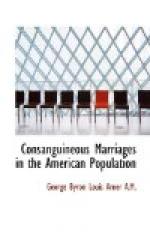The superposition and crossing of cultures, the development of secondary civilization, is necessary to social evolution in its broadest sense, and this usually involves crossing of blood as well as crossing of cultures. As a result of the unprecedented migrations of the last half-century we have in the United States the greatest variety of social types ever brought so closely together. An opportunity is offered either for the perpetuation of each racial type by inbreeding, with the prospect of an indefinite stratification of society, or for the amalgamation of all cultural and racial elements into a homogeneous whole, and the development of a race more versatile and adaptable than any the world has yet known. The general tendency will undoubtedly be toward amalgamation, but there are decided tendencies in the other direction, as for instance in the “first families of Virginia,” and in that large element of the New England population which prides itself upon its exclusively Puritan ancestry, and which has inherited from its progenitors that intolerance which characterized the early settlers of New England more than the pioneers of the other colonies. The dynamic forces of modern civilization are, however, opposed to caste—the West has long ago obliterated the distinction between the Pennsylvania German and the Puritan, the Scotch-Irish and the Knickerbocker Dutch. These same dynamic forces, which have prevented the formation of caste have at the same time been diminishing the percentage of consanguineous marriage and will undoubtedly continue to operate in the same way for some time to come. And when rational laws prohibit the marriage of the diseased and the degenerate, the problem of consanguineous marriage will cease to be of vital importance.
BIBLIOGRAPHY.
Barr, M.W. Mental Defectives. Philadelphia, 1904.
Bell, A.G. Marriage—An Address to the
Deaf. Second Edition.
Washington, 1891.
Memoir upon the Formation of a Deaf
Variety of the Human Race.
Washington, 1884.
Bemiss, S.M. “Report on the Influence of
Marriages of Consanguinity
upon Offspring.” In Transactions
of the American Medical
Association, vol. xi, 1858, pp. 319-425.
Boudin, J.C.M.F.J. “Du Croisement des families,
des races et de
especes.” In Memoires de
la Societe d’Anthropologie, vol. i.
Paris, 1860-1863.
Child, G.W. “On Marriages of Consanguinity.”
In Medico-Chirurgical
Review, Apr. 1862, pp. 461-471.
London.
Dally, E. “Rapport sur les mariages consanguins.”
In Bulletins de la
Societe d’Anthropologie.
Paris, 1877.
“Recherches sur les mariages consanguins
et sur les races pures.” In
Bulletins de la Societe d’Anthropologie.
Paris, 1863.
Darwin, G.H. “Marriages of First Cousins
in England and Their
Effects.” In Journal of
the Statistical Society of London, vol.
38. London, 1875.




